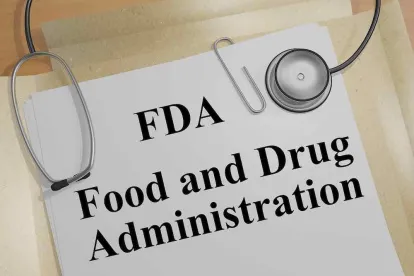On April 3, 2023, the U.S. Food and Drug Administration (FDA) published a groundbreaking draft guidance concerning the use of artificial intelligence/machine learning (AI/ML) in medical devices (Draft Guidance).[1] This notable move suggests FDA’s intent to provide a forward-thinking, least burdensome approach to support the development of safe and effective medical devices that use machine learning-enabled device software functions (ML-DSF).
The Food and Drug Omnibus Reform Act of 2022 added Section 515C to the Federal Food, Drug, and Cosmetic Act (FDCA). This new section provides FDA with the authority to review and authorize Predetermined Change Control Plans (PCCPs or Plans) for medical devices.[2] Under FDCA § 515C, if a PCCP for a device is authorized by FDA as part of an underlying premarket submission, changes made to the device do not need premarket approval supplements or new 510(k) notifications, provided the changes are consisted with the Plan. This approach allows manufacturers to proactively pre-specify and seek authorization for intended modifications that may ordinarily trigger new submissions or filings to FDA. Specifically, the Draft Guidance provides recommendations on the submission content of PCCPs.
History of FDA’s Approach to the Use of AI/ML in Medical Devices
In April 2019, FDA published an initial discussion paper regarding AI/ML-based software as a medical device.[3] Since then, FDA has held several public meetings and workshops on AI/ML, focused on specific medical uses, fostering patient trust, and overall device safety and effectiveness.[4] FDA also issued a finalized AI/ML action plan in January 2021.[5] As of October 2022, FDA has authorized over 500 AI/ML-enabled medical devices via the 510(k), De Novo, and Premarket Approval (PMA) pathways.
In addition to FDA’s focus on AI/ML devices, the White House released a Blueprint for an AI Bill of Rights (Blueprint) on October 4, 2022. The Blueprint discusses the following principles regarding the design, use, and deployment of automated systems: (1) safe and effective systems; (2) algorithmic discrimination protections; (3) data privacy; (4) notice and explanation; and (5) human alternatives, consideration, and fallback. FDA states that the Draft Guidance is consistent with and promotes the Blueprint’s principles.
Draft Guidance: Policy for PCCPs
The Draft Guidance seeks to strike a balance between the iterative nature of AI/ML software development to improve devices and ensuring that devices remain safe and effective. Specifically, the Draft Guidance contains the following recommendations regarding PCCPs:
-
Components of a PCCP. Plans should contain: (1) a detailed “Description of Modifications,” (2) a “Modification Protocol,” and (3) an “Impact Assessment.”[6] FDA views a PCCP to be part of the technological characteristics of a device.
-
Establishing a PCCP. Marketing submissions should contain a PCCP prior to implementing modifications under that Plan. When a manufacturer wants to establish a new PCCP for a previously-authorized device with a PCCP, FDA intends to focus its review on the most significantly modified aspects of the device.
-
Identifying a PCCP in a Marketing Submission. PCCPs should be included in the marketing submission as a standalone section, titled as such, and should be prominently included and discussed in the marketing submission cover letter. FDA may require that a PCCP include labeling needed for safe and effective use of the device.
-
Utilizing an Authorized PCCP to Implement Device Modifications. Manufacturers should evaluate a PCCP within the device’s existing risk management framework and quality system. Modifications must be consistent with the Description of Modifications and implemented in line with the Modification Protocol outlined in the Plan. If the modifications are inconsistent with the Plan, then a new marketing submission may be required. FDA warns that continued distribution of the medical device without submitting a new marketing submission would result in the device being adulterated and misbranded.
-
Modifying a PCCP for an Authorized Device. Subsequent modifications to an authorized PCCP will likely require a new marketing submission for the device. In situations where modifications to the PCCP are the only significant modifications since prior FDA authorization, the agency intends to focus its review on the revised PCCP.
Additionally, appendices in the Draft Guidance contain example elements of the components of a Modification Protocol and example scenarios of software manufacturers implementing ML-DSF changes under a PCCP.[7]
FDA Webinar and Public Comments
FDA is hosting a public webinar for medical device manufacturers and other stakeholders to discuss the Draft Guidance on Thursday, April 13, 2023 at 1:00 PM ET. Stakeholders can also submit public comments regarding the Draft Guidance on or before July 3, 2023 to Docket ID FDA-2022-D-2628 at www.regulations.gov/. FDA will implement the guidance upon finalization.
Paul Clowes, law clerk in the Greenville office, contributed to the drafting of this post.
FOOTNOTES
[1] The Draft Guidance is titled, “Marketing Submission Recommendations for a Predetermined Change Control Plan for Artificial Intelligence/Machine Learning (AI/ML)-Enabled Device Software Functions” (Apr. 2023).
[2] Newly-added FDCA § 515C is available at pp. 1377–78, https://www.congress.gov/117/bills/hr2617/BILLS-117hr2617enr.pdf.
[3] See Proposed Regulatory Framework for Modifications to Artificial Intelligence/Machine Learning (AI/ML)-Based Software as a Medical Device (SaMD) – Discussion Paper and Request for Feedback (Apr. 2019).
[4] See Public Workshop – Evolving Role of Artificial Intelligence in Radiological Imaging (Feb. 2020); Patient Engagement Advisory Committee Meeting Announcement (Oct. 2020); Virtual Public Workshop – Transparency of Artificial Intelligence/Machine Learning-enabled Medical Devices (Oct. 2021).
[5] See Artificial Intelligence/Machine Learning (AI/ML)-Based Software as a Medical Device (SaMD) Action Plan (Jan. 2021).
[6] Specific requirements for these three elements can be found on pages 16–25 of the Draft Guidance.
[7] Appendix A (pp. 26–32 of the Draft Guidance) is titled, “Example Elements of Modification Protocol Components for ML-DSFs” and Appendix B (pp. 33–39 of the Draft Guidance) is titled, “Example ML-DSF Scenarios Employing PCCPs.”




 />i
/>i
